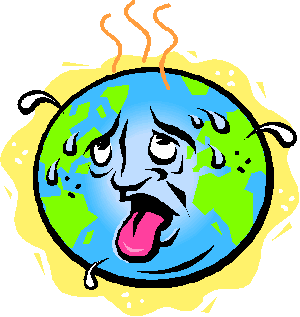IT'S GETTING HOTTER DAY BY DAY
1:22 PM GLOBAL WARMING is the increase in the average temperature of the Earth's near-surface air and the oceans since the mid-twentieth century and its projected continuation. Global surface temperature increased 0.74 ± 0.18 °C (1.33 ± 0.32 °F) during the 100 years ending in 2005. The Intergovernmental Panel on Climate Change (IPCC) concludes that anthropogenic greenhouse gases are responsible for most of the observed temperature increase since the middle of the twentieth century,and natural phenomena such as solar variation and volcanoes probably had a small warming effect from pre-industrial times to 1950 and a small cooling effect from 1950 onward.These basic conclusions have been endorsed by more than 40 scientific societies and academies of science,including all of the national academies of science of the major industrialized countries.
Climate model projections summarized in the latest IPCC report indicate that global surface temperature will likely rise a further 1.1 to 6.4 °C (2.0 to 11.5 °F) during the twenty-first century.The uncertainty in this estimate arises from the use of models with differing climate sensitivity, and the use of differing estimates of future greenhouse gas emissions. Some other uncertainties include how warming and related changes will vary from region to region around the globe. Although most studies focus on the period up to 2100, warming is expected to continue beyond 2100, even if emissions have stopped, because of the large heat capacity of the oceans and the lifespan of CO2 in the atmosphere.
An increase in global temperature will cause sea levels to rise and will change the amount and pattern of precipitation, probably including expansion of subtropical deserts. Warming is expected to be strongest in the Arctic and would be associated with continuing retreat of glaciers, permafrost and sea ice. Other likely effects include changes in the frequency and intensity of extreme weather events, species extinctions, and changes in agricultural yields.Warming and related changes will vary from region to region around the globe, though the nature of these regional variations are uncertain. Political and public debate continues regarding global warming, and what actions (if any) to take in response. The available options are mitigationto reduce further emissions; adaptation to reduce the damage caused by warming; and, more speculatively, geoengineering to reverse global warming. Most national governments have signed and ratified the Kyoto Protocol aimed at reducing greenhouse gas emissions.

*******************************************
extracted from :



0 comments